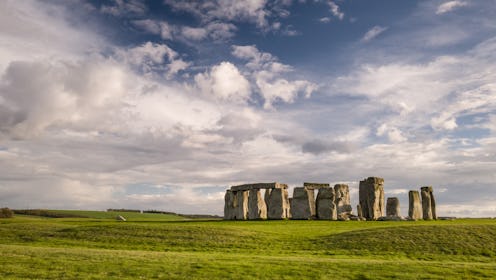Life
Remains Of Women In Power Found At Stonehenge
Historical accounts of Stonehenge have often portrayed the site as a male-dominated space, but a recent archeological study suggests that women may have played a larger role in life near the prehistoric landmark than previously thought. In an excavation of cremated remains, archeologists found many high-status women buried at Stonehenge — in fact, they unearthed more women buried at the landmark than men. The study is to be published in the March/April issue of British Archeology, and its findings have the journal proclaiming, “Stonehenge was not just a man thing.”
These results come out of an excavation conducted in 2008 of a chalk pit known as “Aubrey Hole 7.” Archeologists extracted 99 pounds of bone fragments and other materials, which were then painstakingly sorted and examined by Christie Willis, a Ph.D. student at University College London’s Institute of Archaeology. She was ultimately able to identify remains from 23 distinct people, 14 of whom were women.
In an interview with Discovery News, Mike Pitts, archeologist and editor of British Archeology, explained that Willis’s findings create a very different picture of life at Stonehenge than the one we’re used to seeing. “In almost every depiction of Stonehenge by artists and TV re-enactors we see lots of men, a man in charge, and few or no women,” he said. “The archaeology now shows that as far as the burials go, women were as prominent there as men. This contrasts with the earlier burial mounds, where men seem to be more prominent.”
The research confirms earlier theories that the notoriously-mysterious Stonehenge once functioned as a burial site for cremated remains. Pitts said that we can assume that people buried there — including the 14 women the archeologists found — were important, powerful figures because of the location and cultural significance of Stonehenge. He remarked, “By definition — cemeteries are rare, Stonehenge exceptional — anyone buried at Stonehenge is likely to have been special in some way: high status families, possessors of special skills or knowledge, ritual or political leaders.” Analysis revealed that the human remains found at Aubrey Hole 7 were buried there between 3100 B.C. and 2140 B.C.
Although these findings suggest that the women of Stonehenge at times held high prominence in their society, their status changed over time. Willis explained to Discovery News that “the role of women in society ‘probably declined again towards the 3rd millennium B.C…both archaeological and historical evidence has shown that women’s status has gone up and down quite noticeably at different times in the past.’”
